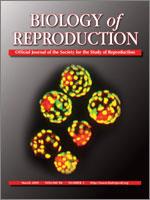In mammals, circadian genes, Clock, Arntl (also known as Bmal1), Cry1, Cry2, Per1, Per2, and Per3, are rhythmically transcribed every 24 h in almost all organs and tissues to tick the circadian clock. However, their expression and function in oocytes and preimplantation embryos have not been investigated. In this study we found that the circadian clock may stop in mouse oocytes and preimplantation embryos. Real-time PCR analysis revealed the presence of transcripts of these genes in both oocytes and preimplantation embryos; however, their amounts did not oscillate every 24 h in one- to four-cell and blastocyst-stage embryos. Moreover, immunofluorescence analyses revealed that CLOCK, ARNTL, and CRY1 were localized similarly in the nuclei of germinal vesicle (GV) oocytes and one-cell- to four-cell-stage embryos. Because CRY1 is known to interact with the CLOCK-ARNTL complex to suppress transcription-promoting activity of the complex for genes such as Wee1, Cry2, Per1, Per2, and Per3 in cells having the ticking circadian clock, we hypothesized that if the circadian clock functions in GV oocytes and one-cell- to four-cell-stage embryos, CLOCK, ARNTL, and CRY1 might suppress the transcription of these genes in GV oocytes and one-cell- to 4-cell-stage embryos as well. As a result, knockdown of CRY1 in GV oocytes by RNA interference did not affect the transcription levels of Wee1, Cry2, Per1, Per2, and Per3, but it reduced maturation ability. Thus, it seems that circadian genes are not involved in circadian clock regulation in mouse oocytes and preimplantation embryos but are involved in physiologies, such as meiosis.
How to translate text using browser tools
1 March 2009
Expression and Functional Analyses of Circadian Genes in Mouse Oocytes and Preimplantation Embryos: Cry1 Is Involved in the Meiotic Process Independently of Circadian Clock Regulation
Tomoko Amano,
Akinori Matsushita,
Yuki Hatanaka,
Tatsuya Watanabe,
Katsutaka Oishi,
Norio Ishida,
Masayuki Anzai,
Tasuku Mitani,
Hiromi Kato,
Satoshi Kishigami,
Kazuhiro Saeki,
Yoshihiko Hosoi,
Akira Iritani,
Kazuya Matsumoto
ACCESS THE FULL ARTICLE

Biology of Reproduction
Vol. 80 • No. 3
March 2009
Vol. 80 • No. 3
March 2009
circadian clock
circadian genes
meiosis
mice
Oocytes
preimplantation embryos




